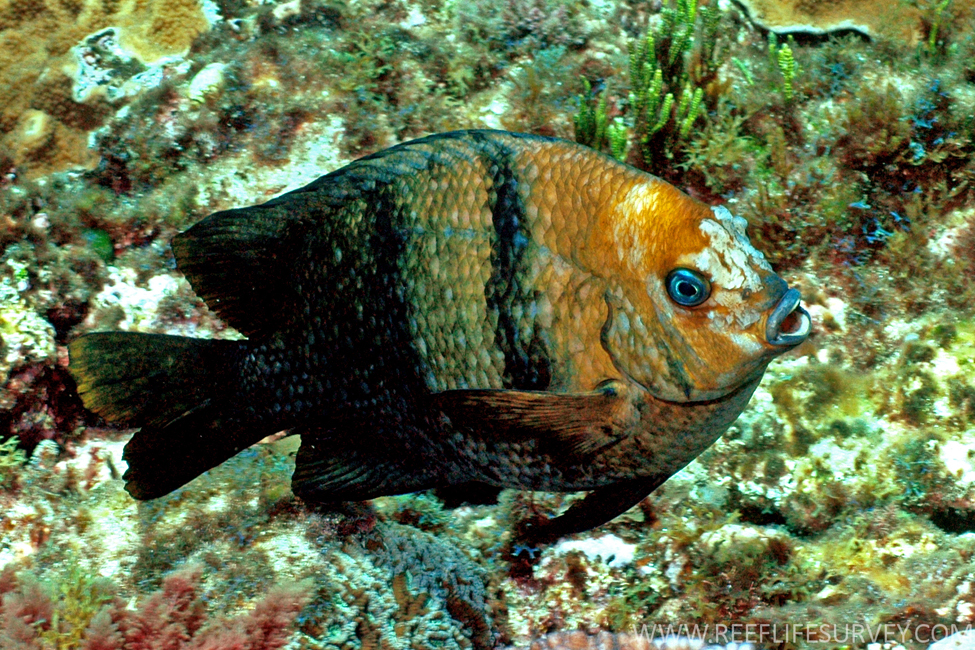Banded Scalyfin, Parma polylepis Günther 1862

A Banded Scalyfin, Parma polylepis, in the Lord Howe Island lagoon inside North Head, Tasman Sea. Source: Graham Edgar / Reef Life Survey. License: CC by Attribution
• Large fish (greater 100 mm SL) have bony knobs above and between the eyes, that become larger and more noticeable as the fish grows;
• Individuals smaller than 125 mm SL have two pale bars on the sides, and often have an ocellus at the junction between the dorsal-fin spines and the soft dorsal-fin rays.
Banded Scalyfin, Parma polylepis Günther 1862
More Info
|
Distribution |
Recorded in Australia from One Tree Island, Capricorn Group, Great Barrier Reef, Queensland, to about Sydney, New South Wales; also at Lord Howe and Norfolk islands, and Elizabeth and Middleton reefs in the Tasman Sea. Very common around Lord Howe Island and Norfolk islands. Adults inhabit lagoons and outer reefs, including surge channels in depths to 40 m. |
|
Features |
Dorsal fin X111, 17-19; Anal fin II, 13-14; Pectoral fin 20-22;Lateral line scales (tubed) 26-33; Gill rakers 7 to 11 + 1 + 9 to 11 (total 17 to 23); Teeth in jaws: 48-56. Body depth 1.6 to 1.7 in SL; head length 3.2 to 3.4 in standard length; snout 2.5 to 2.7, eye 3.2 to 4.1, interorbital 2.3 to 2.8 in HL; caudal peduncle depth 1.7 to 1.9 in HL, length of caudal peduncle 3.3 to 4.0 in HL. |
|
Colour |
Juveniles (about 25-80 mm SL) with two prominent whitish bars on sides, the first from base of anterior dorsal-fin spines to behind and below the pectoral-fin base; the second from base of 9th-11th dorsal-fin spines to the anal-fin origin. Tail base, breast and lower part of head reddish-brown; a dark brown streak on the gill cover; an indistinct pale band extending from nape to lower edge of gill cover; spinous dorsal fin brown to dusky, except where interrupted by extensions of pale bars on sides Soft dorsal fin dark brown basally, translucent distally, with a pale-rimmed black ocellus between the 10th dorsal-fin spine and 2nd or 3rd soft ray; ocellus rimmed with an iridescent pale blue in juveniles. Anal and pelvic fins mostly dark brown to blackish; caudal fin dusky to translucent; pectoral fins pale with a dark spot on upper portion of fin base and frequently on lower corner. Juveniles often have yellowish fins. The ocellus and pale bars gradually fade with growth. The ocellus usually disappears before individuals reach about 100 mm SL, and the bars are usually lost between about 110-140 mm SL. The ocellus is sometimes replaced by a whitish blotch in subadults. At Lord Howe Island, the upper part of the head is usually yellowish in adults. In northern New South Wales mature adults may have a pale band behind the head. |
|
Feeding |
Feed mostly on algae. |
|
Biology |
The sexes are separate and males and females form pairs during the breeding season. Females lay demersal adherent eggs onto an area or 'nest' cleared by the male. Males aggressively guard and aerate the eggs until the larvae hatch. |
|
Species Citation |
Parma polylepis Günther, 1862, Cat. Fish. Brit. Mus. 4: 59. Type locality: Norfolk Island. |
|
Author |
Bray, D.J. 2017 |
Banded Scalyfin, Parma polylepis Günther 1862
References
Allen, G.R. 1975. Damselfishes of the South Seas. New Jersey : T.F.H. Publications 237 pp. 251 figs.
Allen, G.R. 1991. Damselfishes of the World. Melle, Germany : Mergus Verlag 271 pp.
Allen, G. R. 2001. Family Pomacentridae. pp. in Carpenter, K.E. & Niem, T.H. (eds). The Living Marine Resources of the Western Central Pacific. FAO Species Identification Guide for Fisheries Purposes. Rome : FAO Vol. 6 pp. 3381-4218.
Allen, G.R., Cross, N.J. & Allen, C.J. 2006. Pomacentridae. pp. 1439-1471 in Beesley, P.L. & Wells, A. (eds). Zoological Catalogue of Australia. Volume 35 Australia : ABRS & CSIRO Publishing Parts 1-3, 2178 pp.
Allen, G.R. & Hoese, D.F. 1975. A review of the pomacentrid fish genus Parma, with descriptions of two new species. Records of the Western Australian Museum 3(4): 261-294 figs 1-18
Choat, J.H., van Herwerden, L., Robbins, W.D., Hobbs, J.P. & Ayling, A.M. 2006. A report on the ecological surveys undertaken at Middleton and Elizabeth Reefs, February 2006. Report by James Cook University to the Department of the Environment and Heritage. 65 pp.
Francis, M. 1993. Checklist of the coastal fishes of Lord Howe, Norfolk, and Kermadec Islands, southwest Pacific Ocean. Pacific Science 47(2): 136-170 figs 1-2
Francis, M.P. 1988. Confirmation of Parma polylepis, a pomacentrid teleost, in New Zealand waters (note). New Zealand journal of marine and freshwater research, 22(1): 143-145. doi: 10.1080/00288330.1988.9516286
Francis, M.P. 1996. Geographic distribution of marine reef fishes in the New Zealand region. N.Z. J. Mar. Freshwat. Res. 30: 35-55.
Günther, A. 1862. Catalogue of the Fishes in the British Museum. Catalogue of the Acanthopterygii Pharyngognathi and Anacanthini in the collection of the British Museum. London : British Museum Vol. 4 534 pp.
Johnson, J.W. 1999. Annotated checklist of the fishes of Moreton Bay, Queensland, Australia. Memoirs of the Queensland Museum 43(2): 709-762
Kuiter, R.H. 1993. Coastal Fishes of South-eastern Australia. Bathurst : Crawford House Press 437 pp.
Oxley, W.G., Ayling, A.M., Cheal, A.J. & Osborne, K. 2004. Marine surveys undertaken in the Elizabeth and Middleton Reefs Marine National Nature Reserve, December 2003. Townsville : Australian Institute of Marine Sciences 64 pp.
Randall, J.E., Allen, G.R. & Steene, R. 1990. Fishes of the Great Barrier Reef and Coral Sea. Bathurst : Crawford House Press 507 pp. figs.
Randall, J.E., Allen, G.R. & Steene, R. 1997. Fishes of the Great Barrier Reef and Coral Sea. Bathurst : Crawford House Press 557 pp. figs.













